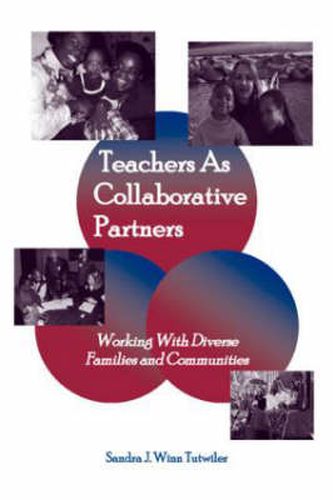Readings Newsletter
Become a Readings Member to make your shopping experience even easier.
Sign in or sign up for free!
You’re not far away from qualifying for FREE standard shipping within Australia
You’ve qualified for FREE standard shipping within Australia
The cart is loading…






Teachers as Collaborative Partners assists future and inservice teachers in developing a research-based framework for understanding the dynamics of school, family, and community relations. It provides foundational knowledge important for understanding families and communities, while exploring conditions that influence family-school-community interactions. The text is designed to engage the critical reflective capability of teachers in ways that will support their ability to work with diverse families in a variety of teaching contexts. Part I focuses first on the social, cultural, and historical roots of the family, with specific attention to the evolution of public schools and the family as interdependent social institutions, and then on the multiple ways families conceive of and conduct family life, as well as the impact of community attributes on the work of families and schools. Part II explores the relationship among families, communities, and schools within social, political, legal, and educational contexts. Part III addresses educational practices that respond to authentic partnerships with families and communities. The goals of the text are supported by pedagogical tools that provide opportunities for readers to make connections between information in each chapter and realistic family-community-school situations. Case Studies are embedded in most chapters. These serve to complement research-based with authentic and personally articulated experiences of parents. Teachers then have the opportunity to make connections between theory and lived experiences. Each chapter includes Inquiry and Reflection questions and Guided Observations to engage readers in case study analysis, situated learning exercises, and classroom and community observations and reflections. The Family-Community-School Profile introduced in this text as a teacher-generated summary allows for evaluation of family-community-school dynamics in specific contexts, and provides teacher candidates opportunities to engage in self-introspection around family-community-school issues before becoming an interacting member of a school-family community. Inquiry and Reflection and Guided Observation activities completed throughout the text are used to generate the Profile. These exercises have been coded to align with specific Profile components. The Profile, which is also aligned with INTASC Principles and NBPTS Propositions, casily becomes a portfolio section documenting teacher skills and knowledge associated with school, family, and community dynamics. Completion of the profile is described in-depth in the text. While the text is aligned with standards and field experiences that are a part of perservice teacher education programs, the content and exercises are equally helpful for inservice teachers wanting to document skills and knowledge in this area as required for National Board Certification.
$9.00 standard shipping within Australia
FREE standard shipping within Australia for orders over $100.00
Express & International shipping calculated at checkout
Teachers as Collaborative Partners assists future and inservice teachers in developing a research-based framework for understanding the dynamics of school, family, and community relations. It provides foundational knowledge important for understanding families and communities, while exploring conditions that influence family-school-community interactions. The text is designed to engage the critical reflective capability of teachers in ways that will support their ability to work with diverse families in a variety of teaching contexts. Part I focuses first on the social, cultural, and historical roots of the family, with specific attention to the evolution of public schools and the family as interdependent social institutions, and then on the multiple ways families conceive of and conduct family life, as well as the impact of community attributes on the work of families and schools. Part II explores the relationship among families, communities, and schools within social, political, legal, and educational contexts. Part III addresses educational practices that respond to authentic partnerships with families and communities. The goals of the text are supported by pedagogical tools that provide opportunities for readers to make connections between information in each chapter and realistic family-community-school situations. Case Studies are embedded in most chapters. These serve to complement research-based with authentic and personally articulated experiences of parents. Teachers then have the opportunity to make connections between theory and lived experiences. Each chapter includes Inquiry and Reflection questions and Guided Observations to engage readers in case study analysis, situated learning exercises, and classroom and community observations and reflections. The Family-Community-School Profile introduced in this text as a teacher-generated summary allows for evaluation of family-community-school dynamics in specific contexts, and provides teacher candidates opportunities to engage in self-introspection around family-community-school issues before becoming an interacting member of a school-family community. Inquiry and Reflection and Guided Observation activities completed throughout the text are used to generate the Profile. These exercises have been coded to align with specific Profile components. The Profile, which is also aligned with INTASC Principles and NBPTS Propositions, casily becomes a portfolio section documenting teacher skills and knowledge associated with school, family, and community dynamics. Completion of the profile is described in-depth in the text. While the text is aligned with standards and field experiences that are a part of perservice teacher education programs, the content and exercises are equally helpful for inservice teachers wanting to document skills and knowledge in this area as required for National Board Certification.